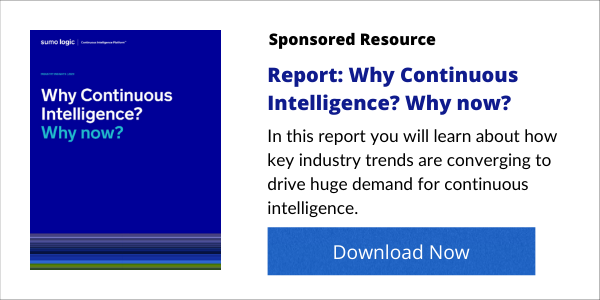
Continuous intelligence delivers real-time analytics and insights into what’s happening and an understanding of the dynamic interactions that occur throughout a company’s digital infrastructure.
The push for digital transformation by many traditional companies is fundamentally driven by the need to drive new revenue growth models. As more and more people become comfortable with meeting the needs of their life and work through digital services, especially as we have collectively experienced through the Covid-19 pandemic, companies that seem to be growing and accelerating during these difficult and unpredictable times are the ones who have figured out the “digital-first mindset.”
See Also: Continuous Intelligence Insights
Hence, they’ve made the shift either by originating as a cloud-based company – think Amazon, Netflix, or Airbnb – or they have successfully transformed a portion of their business into a digital service – think most banking or financial institutions, transportation companies, retail, education, etc. Even a slow-moving industry technology-wise – healthcare – is making the shift with emerging disruptors offering healthcare services supported by online and mobile apps to deliver services online and drive better, frequent communication to patients (another outcome most likely necessitated by the pandemic).
This digital-first mindset is not only a shift to modern technologies – cloud computing and modern applications – it also requires a shift in how companies consume and act upon data and analytics. This shift is essential because cloud and modern application technologies rely on component-based, microservices architectures to develop new and engaging digital services that also, as a by-product, generate extremely large amounts of data at high velocity. In a sense, a digital business becomes a real-time business with an operating model that needs to understand what’s happening as it’s happening. Thus, this new model requires a different kind of intelligence – continuous intelligence.
Continuous Intelligence (CI) is real-time analytics applied to all the real-time data being generated constantly by systems and services on which the digital service runs. In particular, the complex nature of modern operations requires a real-time understanding of the interplay between elements and the performance of the aggregate elements.

Real-time data includes logs, metrics, traces, and other forms of real-time telemetry constantly being generated from cloud-based, modern applications that drive the digital services in use every day. These applications require real-time monitoring and troubleshooting to ensure their reliability and security, with subsequent improvements deployed while the service remains available. In short, for a real-time business operation, there’s no such thing as downtime anymore. The “new business intelligence” for real-time operations is less about gaining insights from data collected and analyzed months ago. It’s more about developers, operators, and security analysts needing to know within hours, minutes, or seconds the complete situational awareness across all their technology systems underpinning their digital service to address the changing nature of their real-time business conditions.
For example, slow response times, faulty shopping carts, or worst yet – a site or service shutting down unexpectedly due to a code glitch – impact both customer experience and revenue for online retail service companies. Digital customers are fickle. If they become dissatisfied with the end-user experience, they can switch to a competitor in seconds and never come back. In addition, the constant bombardment from bad actors and cyber security threats on digital services makes it now impossible to assume firewalls alone will protect the application. In today’s world, faster remediation of threats is just as critical to ensure sensitive business and customer data is not breached. Anything less is a risk to a company’s bottom line, not to mention its brand reputation.
As more companies rely on software code to run their business, they increasingly face a quadruple challenge of visibility, comprehensiveness, speed, and security. First, can they see and monitor all the activity in their digital infrastructure and application environment as it happens, especially when a large portion of it is virtual, automated, and ephemeral? Second, do they have a comprehensive view across all different types of systems and technologies in use in real-time to correlate information across different actions for complete situational awareness at any moment? Third, can they respond quickly to issues for faster resolution and achieve faster insights to speed feature velocity to ensure the experience remains engaging for end-users? And fourth, can they maintain a secure posture across the entire digital application, infrastructure, and data flowing in, through, and out of the system? It amounts to a completely different way of operating – operating in real-time – that challenges how leaders think about driving their processes, teams, and technology investments.
The value of a real-time, continuous intelligence platform vs. a single-use analytics tool
A case in point is the shift in thinking about the best way to leverage analytics tools to drive real-time business needs. Historically, companies have tackled the need for information by leveraging many tools for different use cases, resulting in different data sets with different insights that either have to be stitched together for some kind of broader insight or for supremacy (i.e., who’s data and conclusions are the company going to bet on) when making business decisions. The result is usually a time-consuming process, with lagging indicators from which to make critical business decisions.
The value of a continuous intelligence platform is the strategy (and solution) to implement an intelligence “layer” across the entire digital infrastructure and application(s) for real-time insights across multiple use cases to monitor and address conditions as they are happening. Such a platform would include operations and security monitoring, observability across multiple data types — logs, metrics, traces, and events – and real-time analysis and correlation to spot anomalies and outliers that would otherwise not be known by human intervention alone. The solution can also help identify root causes of problems often buried deep in the system, like a “needle” in a haystack. Knowing this information lets a business do several things:
- Identify root cause issues and speed remediation
- Diffuse security threats
- Improve code deployment speed and quality
- Learn real-time customer use patterns over different business cycles to improve the customer experience and introduce new features and functionality
- Enable business and technology leaders to track business and performance metrics in real-time to ensure service reliability and monitor overall business health.
The hidden benefit of a CI platform: Improved cross-functional collaborations
The power of a real-time, continuous intelligence platform is that, as the intelligence layer of a company’s digital operations, all the uses cases being served are coming from the same data source – the digital service application and its infrastructure. This application and infrastructure (aka, the modern application stack) can consist of many different technologies within the stack itself, from custom code created by the company to third-party applications stitched together via APIs. This heterogeneity of technologies is where a true CI platform shines best because all machine data generated from these systems can be routed through the CI platform and be instantly transformed into analytics for various purposes.
Thus, the different roles and functions across operations, security, customer success, product management, finance, market, sales, and line of business leaders can view data in relevant context from a single “pane of glass” emanating from a core data set – the digital service stack. Gone is the finger-pointing of who’s data is right, and improved cross-functional collaboration to solve issues, introduce better, relevant functionality, and improve customer experience now enters the picture.
Now, these functions can come together to operate in real-time, united across a common purpose, namely the revenue-generating application service. Another hidden benefit of an expansive real-time approach is the enablement of what some call analytic prospecting. It is not just a matter of being able to react in real-time when things change. Ubiquitous continuous intelligence and real-time insights let a business quickly identify and recognize patterns and connections within the data. A business can “look beyond finding the needle to finding patterns that might indicate the presence of a needle,” according to Harvard Business Review.

Such insights can accelerate the transition to real-time operations. Having broad insights across the organization and having analytic prospecting capabilities lets a business see the precursors of those changing conditions. So, rather than reacting to them in real-time, a business can perhaps prevent them from happening altogether.
What’s needed?
Today’s business leaders need real-time intelligence to make critical business decisions and address issues as they are happening. Increasingly this means shifting from a siloed analytics perspective to an intelligence layer that can provide insights across multiple use cases to monitor key performance, service, and risk indicators central to driving digital service revenue. Achieving this goal as a business strategy and technology solution can be accomplished through a real-time, cloud-native, continuous intelligence platform that delivers real-time analytics and insights into what’s happening and an understanding of the dynamic interactions that occur throughout a company’s digital infrastructure.






